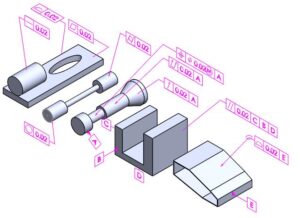- Course fee Includes 6 months of membership and Telephonic Personal consultation for any Tolerance Stack-up related issue.
- For Company – Drawing review and Expert Suggestions, Design and detail engineering. Helping hand in Loop formation and reviewing stack-up analysis.
- Understanding of Basics of GD&T (Couple of hours)

- Tolerance zones, envelopes for All Geometric tolerancing.
- Rule#1
- Rule#2
- Form Tolerances – Straightness, Flatness, Circularity, Cylindricity
- Datum, 3-2-1 principle and Envelopes
- Position Tolerance
- Orientation Tolerance
- Concentricity
- Symmetricity
- Profile of a Line, Profile of a surface
- Circular and Total runout
- Tolerance
- What, Why
- Limits- Fits and Tolerances
- Precision and Accuracy
- Various Fits
- Tolerance Stack-up

- Myths in Tolerance Stack-up
- What is tolerance Stack-up Analysis?
- Why to do tolerance Stack-up Analysis?
- Benefits tolerance Stack-up Analysis
- What are the driving factors in Stack-up analysis
- Assumptions and ways of doing stack-up
- Steps to be followed
- Rules preparing Loop diagram
- Converting all toleracing system to equal bilateral system
- Examples Practice (Part Level and Assembly Level)
- Fixed and Floating Formulas and Concept
- Converting GD&T to Normal ± tolerance to use in stack-up analysis
- Few terminologies (VC, RC, OB and IB, Datum shift)
- Form Tolerances – To include in Tolerance stack-up or not
- Orientation Tolerances on surface and on feature of size
- Profile (Composite tolerance effect as well)
- Positional Tolerance (Composite tolerance, when and how to include segments)
- Datum shift assumption in Tolerance Stack-up
- Runout Consideration
- Symmetry and Concentricity
- Radial Tolerance Stack-up
- Part With Dimension and tolerance at an angle
- Statistical Tolerancing (RSS and MRSS)


Reviews
There are no reviews yet.